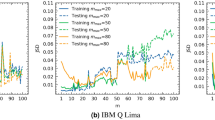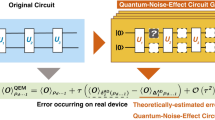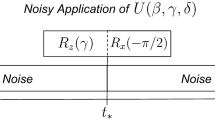Abstract
It is well known that environmental decoherence is a crucial barrier in realizing various quantum information processing tasks; on the other hand, it plays a pivotal role in explaining how a quantum system’s fragile state leads to a robust classical state. Zurek (Nat Phys 5(3):181–188, 2009) was the first to develop the theory which successfully describes the emergence of classical objectivity of quantum systems using decoherence, introduced by the environment. Here, we consider an n-qubit generalized quantum circuit for the quantum system–environment interaction model, where the first qubit represents the quantum system, and the rest are for the environmental fragments. This quantum circuit is implemented on ibmq_athens and ibmq_16_melbourne for \(n = 2, 3, 4, 5, 6\). Its accuracy is checked using quantum state tomography and enhanced using the quantum error mitigation procedure. The reconstructed density matrices are used to investigate quantum-classical correlation and the mutual information between the quantum system and the environment. The investigation proves the quantum Darwinism principle when the quantum circuits are executed on the noise-less simulator; however, it shows the unaccountable behavior when implemented on the real quantum devices. The results via the noise-less simulator successfully prove that the environmental fragment size and the interaction strength play a crucial role in the emergence of classicality.








Similar content being viewed by others
Data Availability Statement
The code base created to run these simulations and the related supplementary data could be made available to any reader upon reasonable request.
References
Schrödinger, E.: The current situation in quantum mechanics. Science 23(50), 844–849 (1935)
Maudlin, T.: Quantum Non-locality and Relativity: Metaphysical Intimations of Modern Physics. Wiley, Hoboken (2011)
Griffiths, R.B.: The consistent histories approach to quantum mechanics (2014)
Zurek, W.H.: Quantum Darwinism. Nat. Phys. 5(3), 181–188 (2009)
Joos, E., Zeh, H.D., Kiefer, C., Giulini, D.J., Kupsch, J., Stamatescu, I.-O.: Decoherence and the appearance of a classical world in quantum theory (2013)
Zurek, W.H.: Decoherence, einselection, and the quantum origins of the classical. Rev. Mod. Phys. 75(3), 715 (2003)
Schlosshauer, M.A.: Decoherence: And the Quantum-to-Classical Transition. Springer, Berlin (2007)
Korbicz, J., Horodecki, P., Horodecki, R.: Objectivity in a noisy photonic environment through quantum state information broadcasting. Phys. Rev. Lett. 112(12), 120402 (2014)
Riedel, C.J., Zurek, W.H.: Quantum Darwinism in an everyday environment: huge redundancy in scattered photons. Phys. Rev. Lett. 105(2), 020404 (2010)
Blume-Kohout, R., Zurek, W.H.: Quantum Darwinism: entanglement, branches, and the emergent classicality of redundantly stored quantum information. Phys. Rev. A 73(6), 062310 (2006)
Zurek, W.H.: Quantum theory of the classical: quantum jumps, Born’s rule and objective classical reality via quantum Darwinism. Philos. Trans. R. Soc. A Math. Phys. Eng. Sci. 376(2123), 20180107 (2018)
QISKit Python SDK. https://github.com/qutip/qiskit-sdk-py
Georgescu, I.M., Ashhab, S., Nori, F.: Quantum simulation. Rev. Mod. Phys. 86(1), 153 (2014)
Ku, H..-Y.., Lambert, N., Chan, F..-J.., Emary, C., Chen, Y..-N.., Nori, F.: Experimental test of non-macrorealistic cat states in the cloud. NPJ Quantum Inf. 6(1), 1–9 (2020)
Behera, B.K., Panigrahi, P.K., et al.: A simulational model for witnessing quantum effects of gravity using IBM quantum computer. Quantum Inf. Process. 19(4), 1–12 (2020)
Lloyd, S.: Universal quantum simulators. Science 273(5278), 1073–1078 (1996)
Biamonte, J., Wittek, P., Pancotti, N., Rebentrost, P., Wiebe, N., Lloyd, S.: Quantum machine learning. Nature 549(7671), 195–202 (2017)
Shenoy, K.S., Sheth, D.Y., Behera, B.K., Panigrahi, P.K.: Demonstration of a measurement-based adaptation protocol with quantum reinforcement learning on the IBM Q experience platform. Quantum Inf. Process. 19(5), 1–13 (2020)
Montanaro, A.: Quantum algorithms: an overview. NPJ Quantum Inf. 2(1), 1–8 (2016)
Harrow, A.W., Hassidim, A., Lloyd, S.: Quantum algorithm for linear systems of equations. Phys. Rev. Lett. 103(15), 150502 (2009)
Mandviwalla, A., Ohshiro, K., Ji, B.: Implementing Grover’s algorithm on the IBM quantum computers. In: 2018 IEEE International Conference on Big Data (Big Data). IEEE, pp. 2531–2537 (2018)
Gisin, N., Thew, R.: Quantum communication. Nat. Photon. 1(3), 165–171 (2007)
Behera, B.K., Reza, T., Gupta, A., Panigrahi, P.K.: Designing quantum router in IBM quantum computer. Quantum Inf. Process. 18(11), 1–13 (2019)
Barik, S., Warke, A., Behera, B.K., Panigrahi, P.K.: Deterministic hierarchical remote state preparation of a two-qubit entangled state using brown et al. state in a noisy environment. IET Quant. Commun. 1(2), 49–54 (2020)
Gisin, N., Ribordy, G., Tittel, W., Zbinden, H.: Quantum cryptography. Rev. Mod. Phys. 74(1), 145 (2002)
Wille, R., Burgholzer, L., Zulehner, A.: Mapping quantum circuits to IBM QX architectures using the minimal number of swap and h operations. In: 2019 56th ACM/IEEE Design Automation Conference (DAC). IEEE, pp. 1–6 (2019)
Azad, U., Papneja, A., Saini, R., Behera, B.K., Panigrahi, P.K.: Circuit centric quantum architecture design. IET Quantum Commun. 2(1), 14–25 (2021)
Zulehner, A., Paler, A., Wille, R.: An efficient methodology for mapping quantum circuits to the IBM QX architectures. IEEE Trans. Comput. Aided Des. Integr. Circuits Syst. 38(7), 1226–1236 (2018)
Anand, A., Behera, B.K., Panigrahi, P.K.: Solving Diner’s dilemma game, circuit implementation and verification on the IBM quantum simulator. Quantum Inf. Process. 19(6), 1–14 (2020)
Eisert, J., Wilkens, M., Lewenstein, M.: Quantum games and quantum strategies. Phys. Rev. Lett. 83(15), 3077 (1999)
Aspuru-Guzik, A., Walther, P.: Photonic quantum simulators. Nat. Phys. 8(4), 285–291 (2012)
Chen, M.-C., Zhong, H.-S., Li, Y., Wu, D., Wang, X.-L., Li, L., Liu, N.-L., Lu, C.-Y., Pan, J.-W.: Emergence of classical objectivity of quantum Darwinism in a photonic quantum simulator. Sci. Bull. 64(9), 580–585 (2019)
Zwolak, M., Quan, H., Zurek, W.H.: Redundant imprinting of information in nonideal environments: objective reality via a noisy channel. Phys. Rev. A 81(6), 062110 (2010)
IBM Quantum Experience. https://www.ibm.com/quantum-computing/technology/experience/
Altepeter, J.B., James, D.F., Kwiat, P.G.: 4 Qubit Quantum State Tomography. Springer, Berlin (2004)
Witten, E.: A mini-introduction to information theory. La Rivista del Nuovo Cimento 43(4), 187–227 (2020)
Zwolak, M., Zurek, W.H.: Complementarity of quantum discord and classically accessible information. Sci. Rep. 3(1), 1–8 (2013)
Zurek, W.H.: Einselection and Decoherence from an Information Theory Perspective. Springer, Berlin (2002)
Ollivier, H., Zurek, W.H.: Quantum discord: a measure of the quantumness of correlations. Phys. Rev. Lett. 88(1), 017901 (2001)
Henderson, L., Vedral, V.: Classical, quantum and total correlations. J. Phys. A Math. Gen. 34(35), 6899 (2001)
Acknowledgements
R.S. would like to thank IIT (ISM) Dhanbad and Bikash’s Quantum (OPC) Pvt. Ltd. for providing hospitality during the course of the project work. R.S. acknowledges Prof. Sridhar Sahu for providing full support during this work. The authors acknowledge the support of IBM Quantum Experience. The views expressed are those of the authors and do not reflect the official policy or position of IBM or the IBM Experience team.
Author information
Authors and Affiliations
Contributions
RS and BKB conceived this research and designed the circuit; RS carried out the experiments and interpret the data; RS wrote the code for experiment and drew all figures and tables. All authors read and approved the final manuscript.
Ethics declarations
Conflict of interest
The authors have no conflict financial and non-financial interest.
Additional information
Publisher's Note
Springer Nature remains neutral with regard to jurisdictional claims in published maps and institutional affiliations.
Rights and permissions
About this article
Cite this article
Saini, R., Behera, B.K. Demonstration of quantum Darwinism on quantum computer. Quantum Inf Process 21, 129 (2022). https://doi.org/10.1007/s11128-022-03471-3
Received:
Accepted:
Published:
DOI: https://doi.org/10.1007/s11128-022-03471-3




